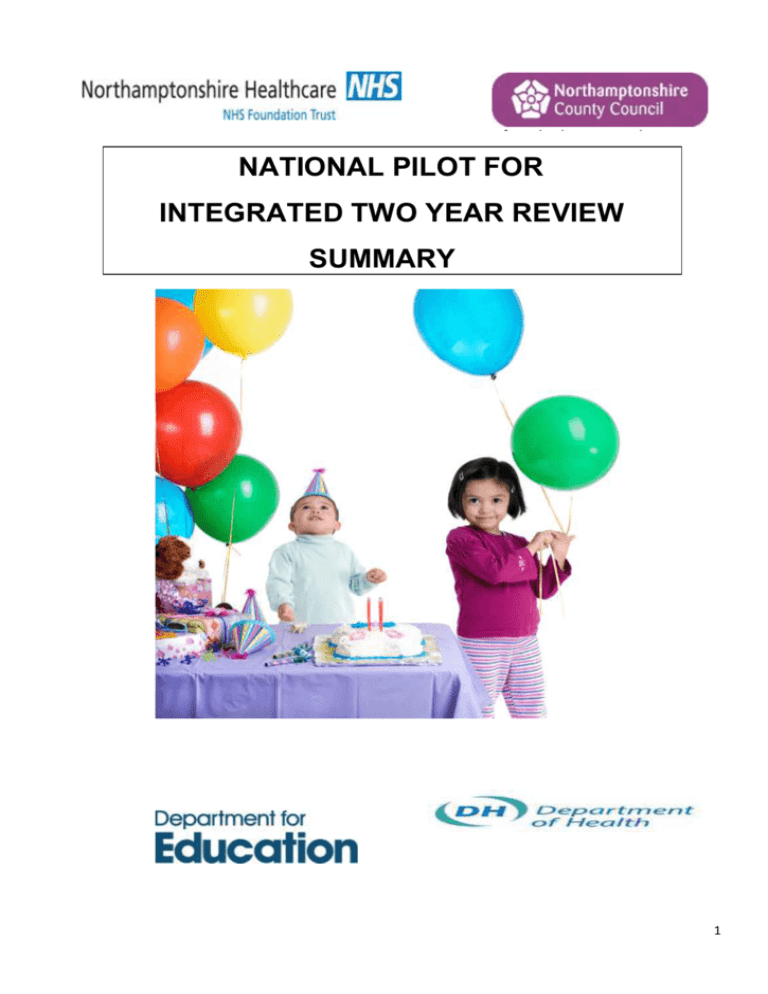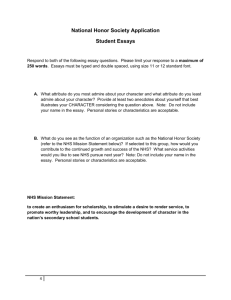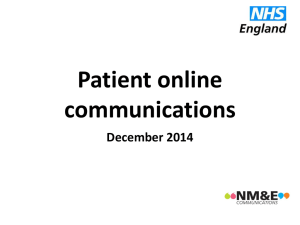The Integrated Review Process:
advertisement

e from the document or the summary of an interesting point. You can position the text box anywhere in the document. Use the Text Box Tools tab to change the formatting of the pull quote text box.] NATIONAL PILOT FOR INTEGRATED TWO YEAR REVIEW SUMMARY SUMMARY 1 Contents Introduction Page 3 Purpose Page 4 The Integrated Review Process Page 6 Additional Information Page 7 Pilot milestones until end of February Page 8 Time table from 28th February 2013 Page 9 APPENDICES 1) Resources Page 10-11 2) Information sharing Page 12 2 INTEGRATED TWO YEAR REVIEW “Age two is an important time for children and their parents”. Introduction This is a crucial time in a child’s life, meetings with children and their parents to review children’s progress is part of both the NHS and the education system programmes. These reviews will identify developmental strengths but also the need for any interventions that can help to make a real difference to a child’s future outcomes. The Healthy Child Programme review is completed at age 2 – 2 ½, and the new Progress Check at age 2 is now part of the Early Years Foundation Stage. However, these two opportunities for reflection and review of a child’s development and health are not integrated in a formal way. On 18 July 2011, Department of Education (DfE) and Department of Health (DoH) jointly published Supporting Families in the Foundation Years. This document makes the commitment to explore options for bringing together the summary of a child’s progress at age two by nurseries and childminders with the Healthy Child Programme 2 – 2 ½ year review. Integrating health and education reviews will give a more complete picture of the child through drawing together the detailed knowledge of how the child is learning and developing day to day at their educational setting with the expertise of the child’s health visitor at the health review, along with parents’ views and concerns about their child’s health and development. It will be more straightforward for parents if their child’s learning and development and health review is presented to them at one contact. Currently there is an uptake of 12% of two year old children in the early year’s settings. However the government is commitment to extending free early education to the most disadvantaged 40% of two year olds. The number of children eligible for the two year old entitlement is estimated at around 3,800 in Northamptonshire. The aim is for as many of those two year olds as possible to be in a setting by September 2014 (although actual uptake may be lower than this initially). Northamptonshire is one of five Health authorities taking part in the national Pilot for the integrated review that is being led by the DfE and DoH. These five areas are exploring ways to integrate these two reviews in order to best facilitate appropriate intervention and support for children and their families, especially those for whom progress is less than expected. We aim to minimise impact on everyone involved whilst exploring this exciting new opportunity for joined approaches and ways of working. 3 “Age two is an important time for children and their parents”. Purpose The Integrated Two Year Review will mean that: Parents receive information about their child’s development and health review that incorporates the professionals who are working together and encourages parents to include their views. Any developmental or health needs are identified at an early point to ensure appropriate support is offered. That there is a clearer pathway for referral and monitoring and support in place to promote the best possible outcome for that child. The Health Visitors will have professional accountability and take the lead during the process. The following currently describes the purpose of the Early Years Settings and Health Visiting Service offer for 2-2 1/2 yr olds, and the areas that are duplicated. This pilot addresses these duplications and offers one process of integrated working. This, as previously stated is one of five pilot sites addressing this issue; all five pilot areas involved have differing approaches: Early Years Settings: - Progress Check A child who attends any form of child care and is aged between two and three, will have their progress reviewed by an Early Years Practitioner, they will provide parents and/or carers with is short written summary of their child’s development in the prime areas of learning (Personal, Social and Emotional development, Communication and Language and Physical development). This progress check must identify the child’s strengths, and any areas where the child’s progress is less than expected.If there are any significant concerns or any identified special educational need or disability the practitioners should develop a targeted plan to support the child’s future learning and development and involve relevant professionals. The Early Years setting follow the Early Years Foundation Stage documents (EYFS) which sets out the Learning and Development requirements for children birth to five in seven areas of learning encompassing children’s physical, intellectual, emotional and social development: Personal, Social and Emotional development Communication and Language Physical development Literacy Mathematics Understanding of the World Expressive Arts and Design 4 “Age two is an important time for children and their parents”. Health Visiting: - Healthy Child Programme- universal offer The Healthy Child Programme currently provides a structured programme; this is offered to all children. Universal Plus and Universal partnership plus will have additional intensive contacts providing support to the child in context and their family. The following are aspects that form the review: Ages and Stages Questionnaire (ASQ) developmental review, this encourages parental involvement. The ASQ has been deemed an appropriate tool to be used during this pilot as it is a reliable and evidenced based tool. Review with parents the child’s social emotional, behavioural and language development and uptake of immunisations to date. Respond to parental concerns about physical development, growth, hearing and vision Offer guidance on behavioural management. Highlight that this is an opportunity to share concerns and information to address worries. Provide advice on nutrition and physical exercise and the promotion of language development. Provide information (including useful telephone numbers and websites) and signposting to relevant services. Raise awareness around dental care, accident prevention, sleep management, toilet training and sources of parenting advice and family information. Maternal mental Health. Interaction between child and parents. 5 The Integrated Review Process Settings verify to HV admin which children are due IR at 2yr 4mths. Some children may have joined setting after Headcount day Childminders inform HV admin which children in their care are due IR Early Years Family Information Service (FIS) inform HV teams via their admin staff, which children are in EY setting, where and the child’s GP HV team take the lead and at cluster/ team meeting identifies children due IR in the following month (children at this point are 2y4m) including those in setting and assess for universal/universal plus services HV admin send letters and ASQs to all parents Extra info for parents of child in setting telling them about their IR meeting in the setting Early Years settings Health Visitors 1. Meet with Children and Families at fixed 1. Collect observational evidence on all children points in child’s life (6wks, 8mths, and 2yrs 6mths) as well as responding to the need of a child as needed 2. Summarise children’s learning for Progress Check at 2years 5 months, or as close as possible, highlighting strengths and areas where development is below expectations (EYFS Development Matters) 3. Share/discuss above with parents together with the ASQ document and parent completed health questionnaire which will provide the parents view of their own child. Agree on next steps to support Learning and development at home and in the setting 4. Health leaflet pack resource given to family 5. Following the IR meeting with parents if child is making expected progress forward the ASQ score sheet and Health question sheet to HVs. Any concerns must be alerted to HV ASAP via telephone as well as any referrals made e.g. SALT etc using established pathways 2. Complete ASQ assessment and Healthy Child programme review with parents, also N’ptonshire Family Assessment Tool for all level 2, 3, and 4s. HV could see any of these children in EY setting if seen as appropriate HV team NNs will go to setting monthly to complete growth measurement and will collect any completed ASQ score sheet, parent completed health questions and a copy of the Progress Check where an issue has been identified 6. Note date of above in child’s Red Book (where parents have produced Red Book) and add if parent has completed ASQ 3. Record outcome in children’s records electronically using System 1 and complete sections of child’s Red Book 4. Receive ASQ information from EY settings for children assessed as universal, and any relevant information from the progress check 5. Add any further relevant info from a child’s EY setting to child’s record 6. Put into action any identified further need for support e.g. SALT using established pathways 7. HV will record any major concerns highlighted by EY settings and respond with appropriate actions Information about the HV team will be made available to the EY setting HVs will be made aware of the EY settings in the GP reach area Strong links with Sure Start Children’s Centres are important. If at any point EY settings have any concerns around the child (in context) communicate concern to HV team for joined up working. All safeguarding issues followed through following LSCB set procedures and policies 6 “Age two is an important time for children and their parents”. Additional Information The Progress Check at 2 currently completed in settings will continue with few minor changes to the pro-forma and process i.e. adding parental consent to share information and moving the completion of the Progress check to 2.5-2.6 months instead of as close to the child’s second birthday as possible. Score sheet and parents health questionnaire must be returned to the HV team. Any relevant information regarding a child that is additional to the background history and gives cause for concern, the HV will ensure that there is a clear care pathway planned and communicates appropriately with relevant agencies. If parents are clear that information must not be shared with HV team, setting is to note that parents do not wish information shared and HV team will follow up. Where children who are not seen as ‘universal’ but are in an EY setting the HV team may conduct the review in the setting with setting contributing to the process if the parent and setting agree. Nursery Nurses working within the HV team will complete the Healthy Child Programme aspects of the review in the setting, by arrangement with the setting. E.g. weight and check height Children with EAL (see Top Tips booklet) ASQ is available in a few other languages but if there is an issue please contact HV team to arrange a translator or identify a family member who can support. Health Visitors and Early Years Settings to communicate with each other regarding referrals. Any more serious issues regarding less than expected progress for children must be alerted to the HV, recorded on child’s record on System 1 and followed up. System1 to have a drop down box for Early Years setting venue. This will enable data to be accessed and reflect the number of reviews carried out during the pilot. . . 7 “Age two is an important time for children and their parents” Time table from March 2013 Time Activity Comments 7th March 2013 Presentation at the Health visitor development day as part of the IR launch Builds on previous presentation to HV team on Progress Check and the IR 14th and 15th March 2013 Launch dates for Early Years settings, Health visitors teams invited. Guest Speaker is Dr Kay Mathieson Early Years Consultant and trainer Opportunity for all settings involved to be fully briefed about the trial, expectations and process 26th March 2013 Second opportunity for HV staff to access the IR presentation 15th April 2013 LAUNCH OF INTEGRATED TWO YEAR REVIEW Mid way Integrated meeting to reflect on the experiences so far External evaluators arranged by the DoH and DfE will be working with Northamptonshire EY and HV practitioners and parents involved in the trial From this date settings involved in the trial will discuss ASQs with parents at the Progress Check meeting when their child is between 2.5 and 2.6 months Awaiting information 31st December 2013 The pilot finishes There will be feedback from the DH and DfE 2014 A case study will be completed Opportunity for all settings to respond to the consultation All trials will be evaluated and findings reported. Potential model defined and consulted upon September 2015 IR rolled out nationally 8 “Age two is an important time for children and their parents”. APPENDIX 1 Resources To support parents, Health Visiting Teams and Early Years Settings staff, the following resource have been compiled. They are not exclusive and you may find many other resources to support your work and support parents Resources for parents includes: Topic Resource Web links Behaviour Birth to 5 book www.nhs.uk/birthtofive NHS Choices website www.nhs.uk/ Birth to 5 book DoH/ www.nhs.uk/birthtofive NHS Choices website www.nhs.uk/ Birth to 5 book DoH/ NHS Choices website www.nhs.uk/birthtofive Birth to 5 book DoH/ NHS Choices website www.nhs.uk/birthtofive Available Birth to 5 book DoH/ NHS Choices website www.nhs.uk/birthtofive Sleeping problems Nutrition Immunisations Safety in and out of the home Leaflets www.nhs.uk/ www.nhs.uk/ www.nhs.uk/ www.rospa.com Dental care Birth to 5 book DoH/ NHS Choices website www.nhs.uk/birthtofive Snack card www.nhs.uk/ Snack card 9 “Age two is an important time for children and their parents”. APPENDIX 1 cont. Early Years staff as above with addition of the following: Healthy Child programme www.dh.gov.uk ASQ www.agesandstages.com Birth to five www.nhs.uk/birthtofive EYFS www.foundationyears.org.uk EY contacts Added to pack Top tips for parents Added to pack Contact details of Health Visiting Teams Added to pack Health Visitor Team Development matters www.foundationyears.org.uk Progress check at two www.foundationyears.org.uk Description of roles Added to pack Top tips for parents Added to pack Details of 2 year olds in a setting Notified by EY settings and also LA 10 “Age two is an important time for children and their parents”. APPENDIX 2 HV Record of Information sharing for the “Integrated Two Year Review” pilot Name Date and time of communication Address Early Years setting Date of Birth GP Record of communication Action plan for identified need Signature 11 Please contact: Pauline O’Neill School Improvement Manager EY poneill@northamptonshire.gov.uk 07841940007 Helen Chappell Locality clinical team facilitator NHFT 07717856412 helen.chappell@nhft.nhs.uk 12






